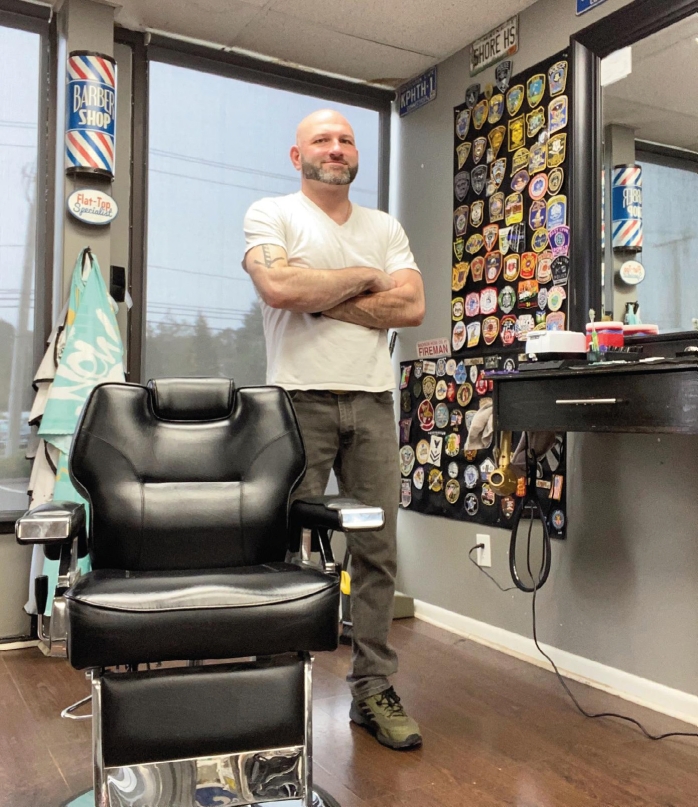To use, add a dime-sized amount of oil into your hand and rub your palms together. Massage it into the desired area. The oil will further the softening of hair and add a layer of lubrication to the skin for your blade to glide smoothly across.
Cutting edge razors: Chances are, you have seen the prices of razors! With an understanding of budget in mind, the adage “You get what you pay for” still reigns supreme. But that does not mean buying a $50+ razor will get you the best shave of your life. The professional opinion is that any double or triple bladed major manufacturer disposable razor will do fine. With that said, you do want to have the sharpest razor you can have. The sharper the blade, the easier it cuts the hair, ultimately giving you the most comfort. When you feel the razor pulling, it’s time to replace the blade. The size of the area that you shave, coupled with the coarseness of your hair will determine your own blade’s life. For some of us, that means a new blade every shave, but the average rule of thumb is 2 to 3 uses. To help prolong the life of your razor, rinse it clean and shake it dry before storing in a dry place.
Shave with the grain. Run your hand down your face. Feels smooth, right? Now run your hand up your face. Kind of like sandpaper, huh? That sandpaper feel is "against the grain". Avoid shaving this direction, it will cut the hair too short and as it grows back it can become ingrown and provide an open vector for bacteria to get inside the pore. This is most prone to be on the neck, but can occur anywhere on the body.

A CUT ABOVE: "Make your shave become a favorite part of your routine. Shaving can be a rewarding, mindful practice that will also help reduce stress and anxiety;" Joe Wadanoli is a Master Barber and owner of Joe & Co. Barbershop in Madison, CT.
Shaving cream: the main purpose of shaving cream is to lubricate the skin for the razor to glide with ease. Find one that has aloe or tea tree oil added, or else try substituting your shave cream with Shea butter, coconut oil, or aloe lotion. It will work just as well (if not better) than the regular stuff. Make sure you rinse off the razor well between strokes! Start with a quarter to half-dollar sized amount of shave cream, gel or lotion in your palm using your palm as a cup. Then, with the back of your other hand's fingers, apply it to the skin in a circular motion. This will aid in standing the hairs up for a
clean cut. You should have a thin layer of lather on your skin, not a full Santa beard of cream—a little goes a long way! Rinse the blade under warm water while tapping the razor head in the sink to knock out any hair caught between the blades. Never wipe the hair out of the razor with your finger. You will cut your finger.
After-shave: Traditional aftershaves contain alcohol. Unfortunately, alcohol dries your skin out, which is counterproductive for our purpose. Tea tree oil will help with soreness and redness, and protect from infection, because tea tree oil contains anti-inflammatory and antimicrobial properties, which make it a perfect post shave option to penetrate the newly open pores and raw skin.
Bumps and acne: If you are prone to
razor bumps, press a cold wet washcloth on the bumps after shaving or whenever you feel the need. The cold water will help shrink the bumps down and sooth any discomfort related. Always keep the affected area moisturized. Lots of us also suffer from pimples. A great way to combat acne is to dab a cotton ball with some apple cider vinegar. The acids in the vinegar will neutralize fungus and bacteria found in acne. It will also help with acne scarring. Apply it to the area morning and night. Fresh aloe applied to the area has been known to soothe painful acne and help with scaring as well. There are aloe gels and lotions you can purchase, or better yet, buy an aloe plant. Just cut inch sized ends off the plant and use the fresh aloe from inside. Just do not forget to water the plant!